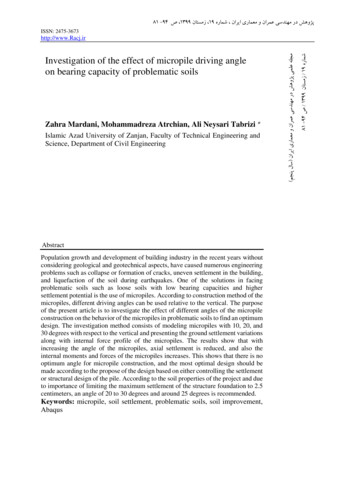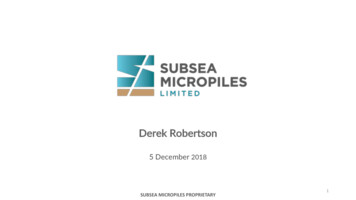
Transcription
keller.comDesign and Construction of High-CapacityMicropiles for ABC ProjectsPaul Liles, P.E. (Retired, GDOT)John Wolosick, P.E. (Keller North America - formerly Hayward Baker)Tony Sak, P.E. (Keller North America - formerly Hayward Baker)ABC-UTC Monthly WebinarJune 18, 2020
Micropiles are a good choice for rapid bridge foundation installations.Although small in diameter, they can carry surprisingly high loadings withsmall deflections. They are not inexpensive, but they can be installed muchquicker than drilled shafts and in limited-headroom and tight-accessconditions.2
Presentation OutlineMicropile OverviewMicropile DesignSpecificationsDesign/BuildMicropile CostsMicropile ConstructionMaterialsEquipmentLoad TestingCase HistoryCourtland Street Bridge, Atlanta3
Micropile Evolution TimelineDeveloped in postWWII Italy as part ofthe rebuilding effort1950s1960sIBC 2006 includes a section onmicropile foundations (Section 1810)1970s1980sIntroduced into theUSA in the early1970’s, but didn’t takeoff until ‘80’s1990sFHWA creates 2documents dedicated tomicropiles: State of thePractice in 1997 and theDesign and ConstructionGuidelines in 2000, 2005 With this history, micropiles are: A non-proprietary geotechnical construction technique Competitively bid by specialty contractors42000s
Micropiles in ABC-UTC Webinars February 13, 2020 – Tennessee DOT’s I-240 MemFix4 CMGC ABC Project December 19, 2019 – Connecticut DOT’s Atlantic Street Railroad BridgeProject Presentations available on ABC-UTC Monthly Webinar Archives5
“Micropiles Should Be Considered”: Where footings cannot be founded at a reasonable expense Where soil conditions would normally allow spread footings but the potential forerosion exists At locations where pile foundations must penetrate rock Difficult subsurface conditions would hinder driven piles or drilled shafts Difficult access or limited headroom preclude use of other deep foundationsystems Foundations must bridge over or penetrate subsurface voids Vibration limits preclude pile driving or access by drilled shaft rigs When underpinning or retrofitting existing foundations6Ref. Section C10.9.1 AASHTO LRFD Bridge Design Specifications 8th Ed.
Micropile InstallationGrout linefrom pumpCasingRetractCasingfrom BondZoneDrillRodUnbondZone(throughweak orcompressiblelayers)Bond Zone(soil or nge/TransferZone
Micropile TypesFounded inDense SoilsS-18S-2Founded inRockR-1R-2
Micropile CapacitiesSteel Pipe SizesFactored Resistance 5-½ inch diameter, 0.415-inch wall thickness:(6-½ inch drill hole)100 tons 7-inch diameter, 0.430 to 0.500-inch wall thickness 7-5/8-inch diameter, 0.500-inch wall thickness:(8 to 8-½ inch drill hole)125-150 tons 9-5/8-inch diameter, 0.472 to 0.545-inch wall thickness:(10-½ inch drill hole)9175-200 tons
FHWA Micropile Manual 2005“The Best Reference forMicropile Design andConstruction” Made available to attendees through ABC-UTC10
Design/Build Micropiles are often a design/build component (or built using aperformance specification) within individual projects. Pre-qualificationof experienced micropile contractors is typically required. Design/build micropiles are usually less expensive, since thecontractor can tailor the constructed product to their equipment andexperience. Therefore, unfamiliar techniques and purchase of newequipment is not required to construct the project. Micropiles are occasionally design/bid/build, particularly in stateswhere design/build is not allowed.11
Micropile Design Steps External - Geotechnical Internal - Structural Connection of Pile to StructureNote: Take advantage of high capacitiesprovided and minimize the numberof micropiles required to carry loadswhich will reduce costs12
Geotechnical Design: Good Quality Geotechnical Data obtain soil samples/rock core and developprofiles estimate design parameters evaluate corrosion potential identify problem areas, if any13
Geotechnical Capacity 0 Factored Resistance 𝑅𝑅 𝑞𝑝 𝑅𝑝 𝑞𝑠 𝑅𝑠TipResistanceEq. 10.9.3.5.1-1AASHTO 8th Ed.SideResistancewhere:fqs resistance factor from table 10.5.5.2.5-1 AASHTO 8th Ed.Rs qs * Asqs grout-to-ground bond resistance (ultimate resistance)As bond zone area pi * bond zone diameter *bond zone length1414
Geotechnical Resistance Factors15Ref. Table 10.5.5.2.5-1 AASHTO 8th Ed.‹#›
Ranges of UltimateBond Stresses in Soilsand Rocks Table 5-3 FHWAMicropile Manual Also Table C10.9.3.5.2-1AASHTO 8th Ed.16‹#›
Structural Capacity - Compression The factored resistance in compression of the piles is as follows: 𝑅𝑐𝑐 𝑐 0.85 (0.85 𝑓 𝑐 𝐴𝑔 𝐹𝑦 𝐴𝑠 ) Eqs. 10.9.3.10-2a-2 and 2b-2AASHTO 8th Ed. Where,fc resistance factor from table 10.5.5.2.5-2 AASHTO 8th Ed.f c UCS of groutAg Net area of groutFy Yield strength of steelAs Area of Steel (casing and/or bar)Note: Fy limited to stress at 0.003 strain (Section C10.9.3.10.2a AASHTO 8thEd.)17
Structural Capacity - Tension The factored resistance in tension of the piles can be calculated as follows: 𝑅𝑡𝑐 𝑡 𝐹𝑦 𝐴𝑠Eqs. 10.9.3.10-3a-2 and 3b-2 AASHTO 8th Ed. Where,ft resistance factor from AASHTO Table 10.5.5.2.5-2 (AASHTO 8th Ed.)Fy Yield strength of the steelAs Area of Steel (casing and/or bar)Note: Fy limited to stress at 0.003 strain (Section C10.9.3.10.2a AASHTO 8thEd.)18
Structural Resistance FactorsRef. Table 10.5.5.2.5-2 AASHTO LRFD Bridge Design Specifications 8th Ed.19
Additional Design Notes Consider loading combinations, especially at pipe joints. If a problem,consider no joints in upper 10 feet or use upper double casing. Lateral load capacity is limited due to small diameters and is a soil/structureinteraction assessment. Loose or soft soils reduce lateral capacity. Usesoftware such as Lpile to evaluate (typically conservative). Evaluate corrosion potential. Use sacrificial steel (1/8-inch) and/or epoxycoating on the thread-bars.20
Typical Micropile Prices - 2020 (mill secondarycasing) Non-Union Areas:Open Headroom: 75- 90/LFLow Headroom: 100/LF Union Areas:21Add 15-20%
Materials - Casing Oil Well Casing – API standards Fy 80 ksi(Note! High Strength Steel) Threaded Pipe Sections 0.5-inch wall thickness “Structural Grade” mill secondary – no millcertificates Casing made in USA but does not comply withBuy America(n) – “Prime” casing which comeswith mill certificates is very expensive.5.5, 7, 9.625-inch OD most common sizes22
Pipe/Casing Tapered andThreaded JointsProvides 100% Load in CompressionProvides 50% in BendingProvides about 50% in Tension, orcarried by thread-bars23
Materials - Steel thread-barsDywidagWilliams Steel Grades Grade 60 Grade 75 Grade 80, 95, 100 Grade 150 (fy 120 ksi) Coupled bars24
Steel Bar with Plastic Centralizer25
Materials - Grout Neat Cement withwater/cement ratio of0.45 (no aggregate) Admixtures may beSuperPlasticizer (waterreducer) Compressive strength of4,000-6,000 psi fordesign calculations Batched on-site26
Grout InstallationTremie Grout27Pressure Grout
Tension Connections28
Equipment Drilling: Modern HydraulicDrills From oil well industry Very fast drilling speeds: 1-2 ft/minute Same rate in soil or rock!29‹#›Project:Low-overhead restriction60-foot piles installed in 3-foot sections
Duplex Drilling30 Often specified - less riskthan open hole drilling Minimal loss of ground incohesionless soils Grouted through thecasing - then pulled withtremie head or excesspressure
Duplex Drill Casing and Down-the-Hole Hammer31
Load Testing Micropiles react similarly in compression and in tension (note same resistancefactor). Therefore, tension testing, which costs ¼ compared to compressiontesting, is used frequently, and provides conservative results since no endbearing occurs.32
Compression Test requires 4 tiedown anchorswhich are expensive33
Lateral Load Test – 2 for 1!Concentric steel pipe for additional lateral resistanceTappan Zee Bridge Replacement (2018)12-inch diameter34
ABC - Courtland Street Bridge ReplacementAtlanta, Georgia 2018 21 million bridgereplacement – design/build( 25 million estimate) Approximately 80% of thenew bridgemicropiles/substructure wereinstalled prior to demolition ofthe old bridge 2019 Small Project Award byDesign-Build Institute ofAmerica35
Project Details Georgia DOT design/build letting – July 2017 Contractor – C.W. Matthews Contracting Company Designer – Michael Baker International Micropile design/build subcontractor – Keller North America Schedule driven Project of this size normally a 2-year duration Project requirement - existing bridge out of service for 155 days36
Project Location – Atlanta, Georgia37
Project Details 1,131 ft, 28-span viaduct replacement ADT - 18,400 12-span bridge with 4-lanes and sidewalks 3 micropile verification tests 13 micropile proof tests – 1 per bent Conventional superstructure construction (no sliding bridge or off-siteconstruction) See time lapse at st.aspx38
Georgia State University30,000 studentsState Capital Building39
Many states, suchas Georgia Section999 shown here,have written theirown micropilespecial provisionsor specifications40
Courtland Street Bridge Micropile Sections4141
Bridge Foundation Plan – Bents 10 to 13Compression-Tension Micropiles42
Micropileinstallationunder existingin-service bridge5-foot longdrilling toolsections addedwith separatemachine43
Tremie Grouting Neat Cement. Tremie extendsto the bottom of the pile.44
Tension Load Test – Courtland Street Bridge45‹#›
68-foot micropile90-foot micropile 800 k (400ton) testload0.75” @ 550k 9-5/8-inchOD GR80steel pipe TensionTests460.55” @ 550k
Project Summary Construction began November 2017 Actual bridge out of service dates – May 6 to October 4 (ribboncutting) Micropile Lessons Learned Old fill, 100-year-old utilities – expect the worst Tension testing 47Economical 400,000 reduction in testing cost
Summary – Micropile Bridge Applications Widening Abutments Retrofits/underpinning Erratic or difficult subsurface profile Piles socketed into bedrock GREAT FOR ABC CONSTRUCTION!48
End Thank you for your attention. Submitted questions will be answeredas time allows.Paul Lilesplilesjr@bellsouth.netJohn Wolosickjrwolosick@keller-na.comTony Sakasak@keller-na.com49
performance specification) within individual projects. Pre-qualification of experienced micropile contractors is typically required. Design/build micropiles are usually less expensive, since the contractor can tailor the constructed product to their equipment and experience. Therefore, unfamiliar techniques and purchase of new










